What Is Play Therapy For Autism?

Understanding Play Therapy for Children on the Autism Spectrum
Play therapy is a child-centered, engaging approach that harnesses the natural language of play to support children with autism. It allows children to express themselves, develop social and emotional skills, and build relationships in a safe, supportive environment. By integrating various techniques tailored to each child's needs, play therapy offers a promising pathway to enhance developmental outcomes and emotional well-being.
What Is Play Therapy for Autism?
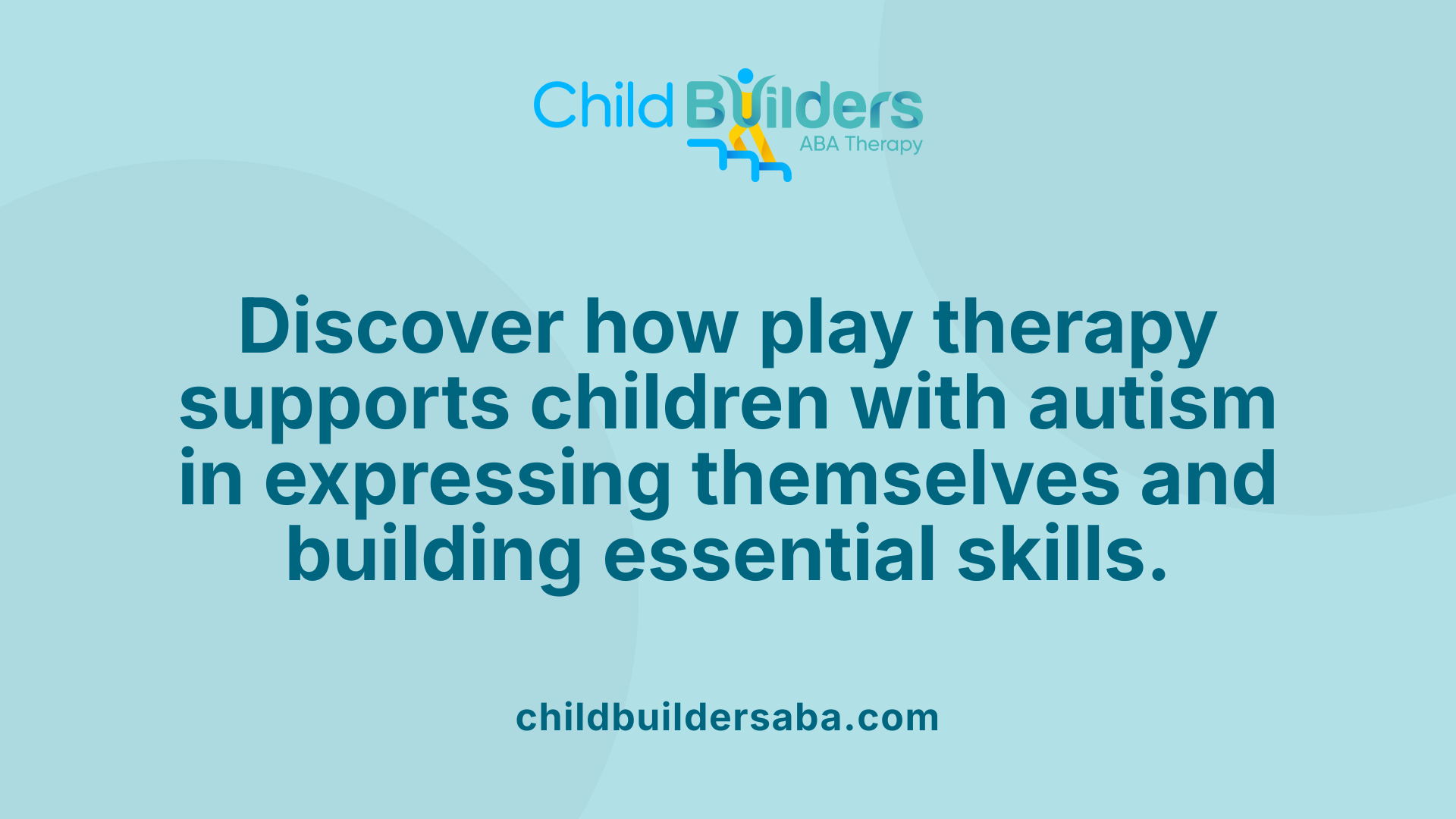
What is play therapy for children with autism?
Play therapy for children with autism is a child-centered and engaging therapeutic method that uses various playful activities to support emotional, social, and communication development. The therapy involves activities such as pretend play, sensory-based activities, storytelling, role-playing, and arts and crafts, all tailored to the child's specific interests and developmental needs.
The main goal is to help children express themselves comfortably, especially those with limited verbal skills or unique sensory processing patterns. By providing a safe space with toys, games, and activities of their choice, children can explore their emotions, connect with others, and improve their social interactions.
Play therapy often involves both the child and a trained therapist working together, with some approaches including family participation to reinforce skills at home. It is adaptable—sessions can be conducted in clinics, schools, or at home—and customized to each child's goals.
Core objectives of play therapy in autism intervention
The primary aims of play therapy are to enhance communication, foster social skills, support emotional regulation, and build relationships. It seeks to shift children's self-expression from unwanted behaviors to more appropriate, non-injurious ways using play as the language.
Through play, children learn to observe and explore their environment, develop empathy, and discover their emotions. Techniques like role-playing, pretend scenarios, and sensory activities help children understand social cues, regulate emotional responses, and increase motor skills.
This approach also aims to decrease problematic behaviors, reduce anxiety, and promote flexibility in thinking. Importantly, therapists observe individual behaviors during play to tailor interventions and set specific, achievable goals.
How play therapy utilizes play as a medium of communication
Play serves as the natural language for children, especially for those facing challenges in verbal communication. Therapists use toys, games, and creative activities to facilitate expression, helping children communicate their feelings and needs non-verbally.
For children with restricted play patterns, such as playing alone or engaging in limited activities, play therapy encourages more spontaneous and imaginative play to foster social interaction. In approaches like Floortime, the therapist or caregiver joins the child's play to promote active engagement, mutual understanding, and emotional development.
Playbased interventions also incorporate visual aids, social stories, sensory experiences, and structured routines that reflect the child's interests, making the communication process more effective. This method supports children in developing self-awareness, understanding social norms, and learning to regulate their emotions—all vital skills for navigating their daily lives.
How Play Therapy Supports Social, Emotional, and Communication Skills
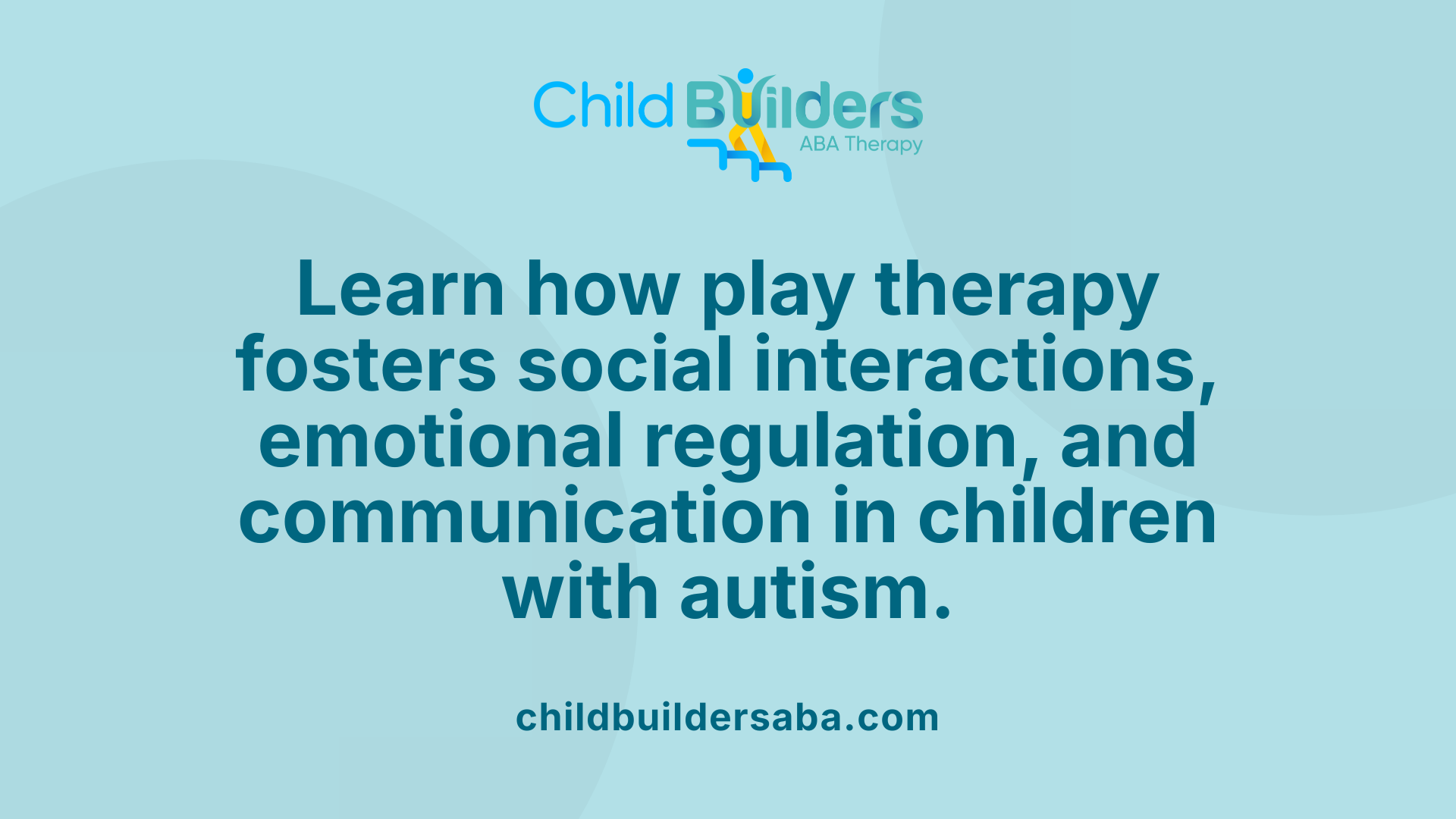
How does play therapy support children with autism?
Play therapy offers a child-centered approach that helps children with autism express themselves comfortably through engaging in activities they choose. This flexibility creates a safe environment where children can develop vital social and communication skills. The natural language of play allows children to practice understanding social cues, sharing, taking turns, and engaging in reciprocal interactions.
In addition to fostering social skills, play therapy helps children regulate their emotions and build trust with their therapist. Using toys, games, and creative activities, children learn to recognize and express their feelings, which can reduce anxiety and improve emotional well-being. Sensory activities and visual aids further support emotional regulation and help integrate sensory processing challenges commonly associated with autism.
Different techniques, such as DIR/Floortime or structured play, are tailored to individual needs, focusing on skills like joint attention, pretend play, and self-calming. The process enhances not only emotional and social competencies but also communication abilities, including both verbal and nonverbal forms.
Though research on the effectiveness of play therapy is still emerging, existing studies indicate it can lead to meaningful improvements in social interaction, emotional regulation, and communication. When integrated with other therapies, play therapy contributes to a comprehensive treatment plan that supports children’s overall development, helping them to connect better with their environment and those around them.
Types and Approaches of Play Therapy Used for Autism
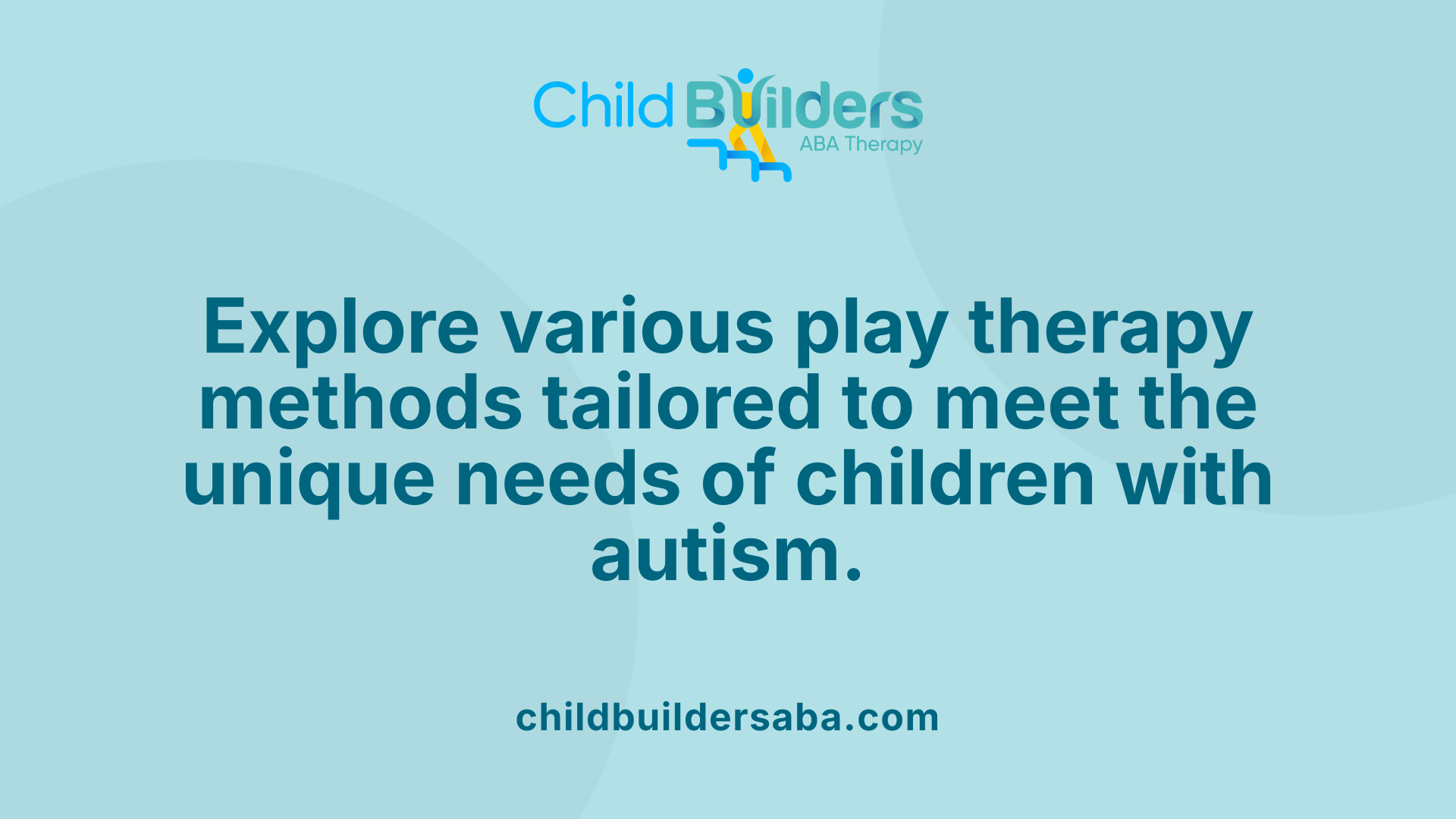 Play therapy employs different strategies to support children with autism, focusing on their unique developmental needs and preferences.
Play therapy employs different strategies to support children with autism, focusing on their unique developmental needs and preferences.
One prominent approach is Child-Centered Play Therapy, which emphasizes spontaneous, unstructured play guided by the child's interests. This method helps build trust and facilitates natural emotional expression. Therapists observe and support children as they explore and communicate through their chosen activities.
Another widely used method is Floor Time or DIR/Floortime (Developmental, Individualized, Relationship-based). In this approach, the therapist or caregiver joins the child on the floor to play at the child's level, encouraging active engagement, understanding of toy mechanisms, and back-and-forth communication. The goal is to promote emotional growth, social connection, and regulate interactions by following the child's lead.
Structured and unstructured play therapies are both adopted based on the child's needs. Structured therapies involve planned activities with specific goals, such as teaching turn-taking or social cues through games or role-playing. These can include techniques like social skills groups, while unstructured play allows children to explore freely, fostering creativity and spontaneous interaction.
Incorporation of sensory activities and visual aids enhances the effectiveness of play therapy. Sensory-based activities—such as swinging, jumping, or using weighted objects—help regulate sensory processing issues common in autism. Visual aids like social stories, visual schedules, and pictorial prompts support understanding and communication, especially for non-verbal children.
Overall, choosing the right type of play therapy involves careful evaluation by professionals, who tailor interventions to the child's specific strengths and challenges. Combining different methods can lead to improvements in social skills, emotional regulation, communication, and adaptive behaviors, creating a nurturing environment for growth.
| Approach | Description | Techniques | Focus Areas |
|---|---|---|---|
| Child-Centered | Spontaneous play guided by child's interests | Free play, emotional expression | Relationship building, trust |
| Floor Time / DIR | Child-led interaction on the floor | Play at child's pace, role-playing | Social-emotional development |
| Structured Play | Planned activities designed to teach skills | Turn-taking games, social scenarios | Social skills, communication |
| Sensory-Based Activities | Activities targeting sensory regulation | Swinging, textured toys, weighted blankets | Sensory processing, calming |
Scientific Support and Evidence for Play Therapy's Effectiveness
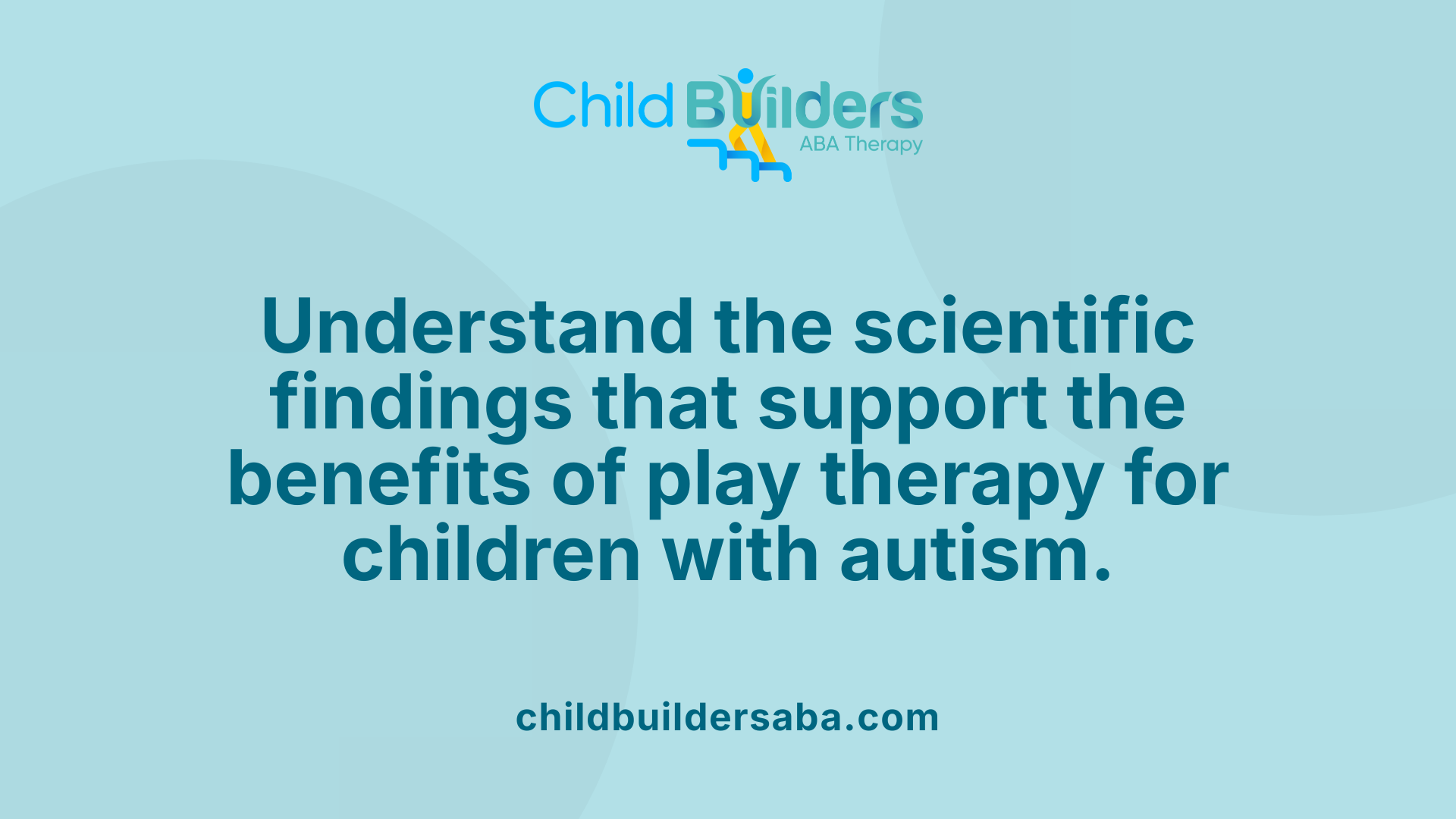 Research studies have generated promising findings regarding the benefits of play therapy for children with autism. These studies often utilize standardized assessment tools such as the Social Responsiveness Scale (SRS-2), Autism Spectrum Quotient (AQ) for children, and the Adaptive Behavior Assessment System (ABAS-II) to measure improvements in social interaction, communication, and adaptive behaviors.
Research studies have generated promising findings regarding the benefits of play therapy for children with autism. These studies often utilize standardized assessment tools such as the Social Responsiveness Scale (SRS-2), Autism Spectrum Quotient (AQ) for children, and the Adaptive Behavior Assessment System (ABAS-II) to measure improvements in social interaction, communication, and adaptive behaviors.
One notable approach, JASPER (Joint Attention, Symbolic Play Engagement and Regulation), has demonstrated significant gains in joint attention, language development, and social engagement. Similarly, the Floortime method, which involves joining the child at their level through playful interactions, has shown positive effects in enhancing social-emotional skills.
In addition to behavioral improvements, neurophysiological changes have been observed. For instance, EEG studies have revealed increased alpha wave activity following play therapy, indicating enhanced neural connectivity and emotional regulation.
Controlled trials indicate that children participating in play therapy display reductions in problematic behaviors, anxiety, and emotional dysregulation. These findings collectively support the potential of play therapy as a component of comprehensive autism interventions.
While the existing research is encouraging, many studies are small-scale case reports. Nevertheless, the evidence underscores that play therapy can foster neural and behavioral improvements, making it a valuable strategy in supporting children with autism.
| Assessment Tool | Focus Area | Study Highlights |
|---|---|---|
| SRS-2 | Social Skills | Significant improvements in social responsiveness |
| AQ-child | Autism traits | Reduced autism-related behaviors post-intervention |
| ABAS-II | Adaptive behavior | Enhanced daily functioning |
| Therapy Technique | Targeted Skill | Notable Outcomes |
|---|---|---|
| JASPER | Joint attention, language | Increased initiation and language use |
| Floortime | Emotional regulation, engagement | Improved smile and eye contact |
| Play-based interventions | Communication and social skills | Reduced anxiety and behavioral issues |
More information about scientific support can be found by searching
Techniques Employed in Play Therapy for Autism
Play therapy for children with autism incorporates a range of strategies designed to meet individual developmental goals. One common technique involves sensory play and sensory integration activities. These include engaging textures, swinging, jumping, and weighted objects to help children process sensory input and regulate their emotions effectively.
Pretend play and role-playing form another crucial aspect. These activities allow children to explore social roles, understand social cues, and develop imagination. Therapists might use dolls, puppets, or real-life scenarios to encourage children to practice social interactions in a controlled environment.
Arts, crafts, and storytelling are also widely used within play therapy. Creative tasks like drawing, painting, and storytelling foster emotional expression and assist children in articulating feelings they may not verbalize easily. These activities help build communication skills and support emotional regulation.
Furthermore, the integration of technological tools such as virtual reality (VR) and augmented reality (AR) expands play therapy options. VR environments can simulate social scenarios, providing a safe space for children to practice social skills and reduce anxiety. These innovations make therapy more engaging and can target specific skills like joint attention and imitation.
Through these diverse techniques, play therapy creates an engaging environment that facilitates emotional, cognitive, and social development. The ultimate goal is to help children with autism express themselves comfortably, improve communication, and build meaningful relationships, often in conjunction with other therapeutic approaches.
Reducing Anxiety and Improving Social Skills through Play Therapy
How can play therapy help reduce anxiety and improve social skills in children with autism?
Play therapy provides a safe and engaging space where children with autism can explore their emotions and socialize at their own pace. By using toys, games, and structured activities, children learn to communicate effectively, recognize social cues, and develop empathy. This nurturing environment helps reduce feelings of anxiety by fostering trust and giving children a sense of control over their interactions.
Through specific techniques such as role-playing, storytelling, and social stories, children gain practical skills for navigating social situations. These methods teach children to share, take turns, and interpret others’ emotions, which are often challenging for autistic children. As children become more comfortable and confident, they demonstrate enhanced emotional regulation and decreased anxiety.
Moreover, play therapy emphasizes independence and self-expression, empowering children to approach social interactions with greater confidence. When caregivers are involved, they learn how to reinforce these skills at home, creating a consistent support system that encourages ongoing emotional and social development.
This approach not only addresses immediate social difficulties but also promotes long-term coping strategies, helping children with autism lead more emotionally balanced and socially connected lives.
The Role of Parents and Caregivers in Play Therapy
How do parents facilitate play therapy at home?
Parents and caregivers play a crucial role in extending the benefits of play therapy beyond clinical sessions. Their active involvement during home-based activities can reinforce the skills and strategies introduced by therapists. This can be achieved by engaging in play sessions that mirror the techniques used during therapy, such as commenting on the child's actions, mimicking behaviors, and encouraging the child to explore activities at their own pace.
Incorporating structured routines and visual aids like social stories or schedules can help children understand expectations and stay engaged. Sensory activities, such as swinging, jumping, or using weighted objects, can serve as calming tools and help regulate sensory processing issues often present in children with autism.
Building trusting relationships through consistent, positive, and supportive interactions fosters a safe environment where children feel valued and motivated to participate. When parents show patience and understanding, children are more likely to become comfortable expressing their emotions and trying new social interactions.
Parental involvement not only reinforces the learned skills but also strengthens family bonds, contributing to the child's overall development. By actively participating, parents help their children build confidence, improve communication, and establish healthy emotional regulation, which are fundamental goals of play therapy.
Challenges, Limitations, and Future Directions in Play Therapy for Autism
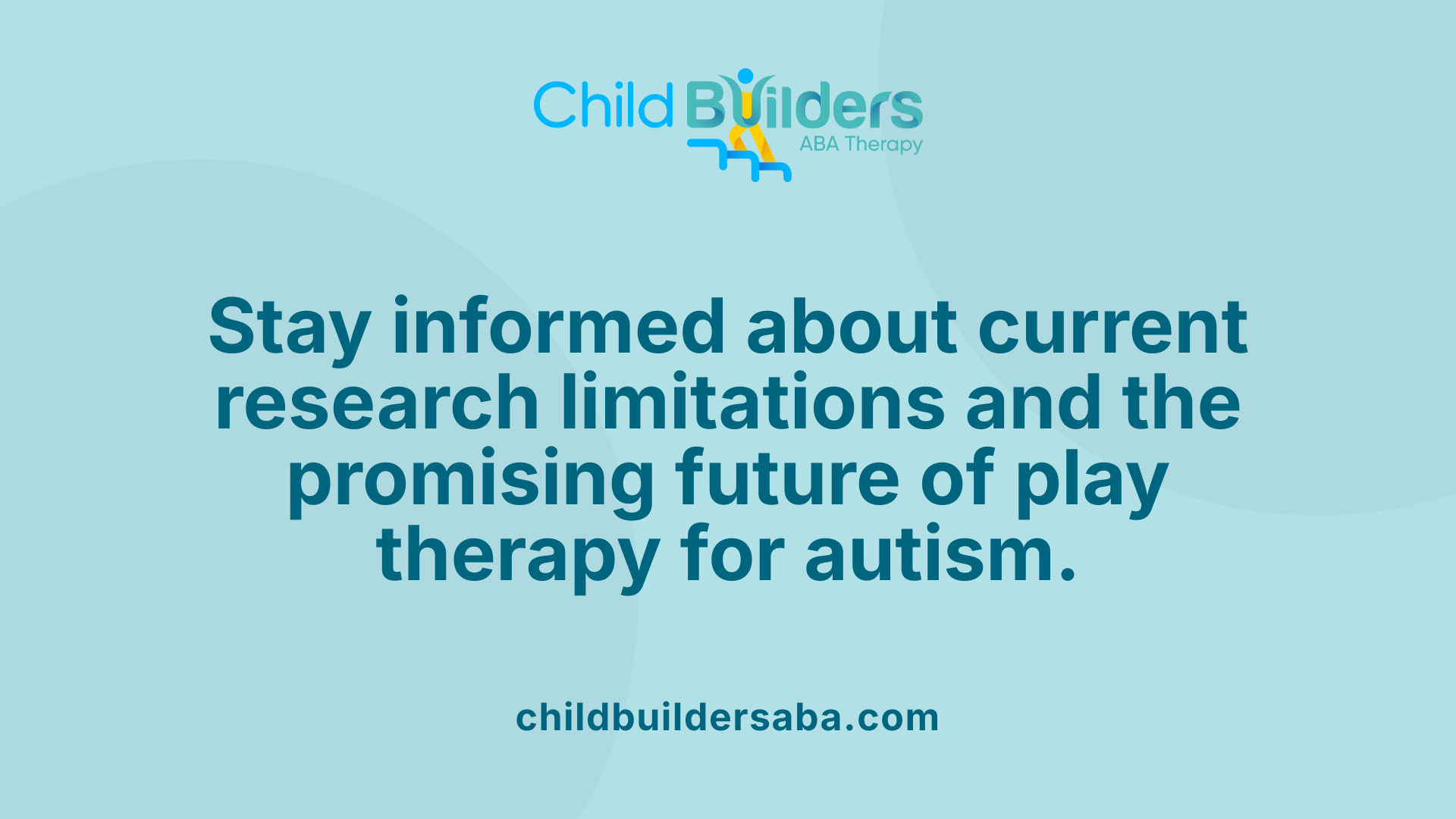
What scientific support and evidence exist for play therapy's effectiveness for children with autism?
Current studies on play therapy for children with ASD provide limited scientific support. Most research has been conducted through case studies involving small groups of participants, which makes it difficult to generalize the results to larger populations. Although existing research indicates small but positive increases in children's social engagement and play interactions, these findings are constrained by methodological issues such as lack of control groups and short follow-up periods.
Due to these limitations, it is challenging to definitively confirm the effectiveness of play therapy as a stand-alone treatment. To establish stronger evidence, more rigorous research designs are needed. Large-scale controlled trials, longitudinal studies, and standardized assessments can help clarify the true benefits and mechanisms of play therapy.
Despite the current evidence gaps, the potential benefits derived from the theoretical compatibility of play therapy with core ASD challenges—such as social communication difficulties and emotional regulation issues—are promising. Many practitioners and researchers remain optimistic that ongoing and future studies will validate play therapy as an effective and integral component of comprehensive autism interventions.
Variability in research findings
Research findings in play therapy for autism vary significantly. While some studies report improvements in social and emotional skills, others show less consistent results. This variability can be attributed to differences in therapy types, sample characteristics, and measurement methods.
Need for rigorous studies with larger samples
To strengthen the evidence base, future research should focus on conducting large-scale, well-controlled studies. Such research is vital for understanding which forms of play therapy are most effective for specific subgroups of children with ASD and for identifying optimal treatment protocols.
Potential and optimism for continued research
Despite current limitations, the theoretical foundation and initial positive outcomes suggest that play therapy has substantial potential. As research methods improve and more studies are carried out, it is expected that play therapy will become more validated within evidence-based practices. This ongoing research will help clinicians better tailor interventions, improve outcomes, and integrate play therapy into multidisciplinary treatment plans for children with autism.
| Aspect | Current State | Future Directions | Additional Notes |
|---|---|---|---|
| Scientific Support | Limited, mainly case studies | Large controlled trials needed | Promising but not yet definitive |
| Research Variability | High variability in results | Standardized protocols and measures | Complex due to diverse therapy types |
| Sample Sizes | Small, often anecdotal | Larger, more diverse samples | Necessary for generalization |
| Long-term Outcomes | Largely unknown | Longitudinal studies | Will clarify sustained benefits |
| Overall Outlook | Cautiously optimistic | Continued rigorous research | Aims to establish play therapy as evidence-based |
Embracing Play as a Therapeutic Tool
While the scientific evidence on play therapy for autism continues to develop, its potential to support children’s social, emotional, and developmental growth remains promising. Its flexible, engaging approach aligns well with the natural behaviors of children, making it a valuable component of holistic autism treatment plans. As research advances, training for therapists and integration with other therapies will likely optimize outcomes, fostering hope for improved quality of life and development for children on the autism spectrum.
References
- Play therapy in children with autism: Its role, implications, and ...
- Play Therapy For Autism: What Parents Need to Know - Blue ABA
- Is Play Therapy an Evidenced-Based Intervention for Children with ...
- Play Therapy for Autism: Benefits, Techniques & Tips - Forbrain
- Play therapy in children with autism: Its role, implications, and ...
- Play Therapy's Role in Pediatric Autism Services for Kids
- The PLAY Project | Autism Treatment | Autism Intervention Program
- ABA Therapy vs. Play Therapy for Your Child - Accel Therapies





.jpg)































































































